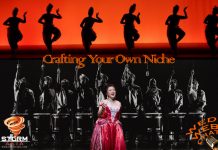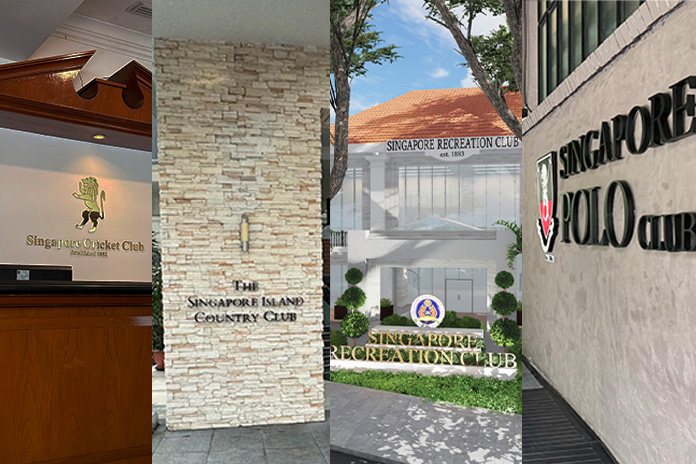
THE ‘5 Cs’ is a phrase familiar with all age groups in Singapore; one of the unofficial core tenets of the fabled ‘Singapore Dream’.
It stands for Cash, Car, Credit card, Condominium, Country club. The emphasis on each has altered over time. While younger generations still value the freedom of mobility offered by cars, the other Cs have faded into the background against ‘community and choice’, while some would say that those in Singapore still value a material lifestyle against a backdrop of security and continued prosperity.
Yet, as times change, the relevance of the original list begins to fade in a dynamic and disruptive world.
Private club membership used to carry an air of prestige among Singapore’s residents, especially the Baby Boomers. But, are they as popular with subsequent generations?
Will the younger generation be as eager to rush in and follow in the older generations’ footsteps? Especially with so many less formal options available — from specific clubs offering targeted services like gyms, to graduate clubs and even condominium clubhouses.
Many of Singapore’s oldest clubs, the first of which, The Singapore Island Country Club (SICC), was established in the late 19th century, were nucleated by clusters of British hobbyists. Their increasing popularity led to a greater demand, which saw membership becoming exclusive and highly reputable. Some clubs feature the bonus of choice locations that include national heritage monuments such as the Padang, and Mandala Club Singapore which is located in a building from 1928 with conservation status, to name a few, while others bear cultural significance as the first places in Singapore to encourage cultural mixing, such as The Singapore Island Country Club‘s (SICC) original Island Club building at Farrer Park.
Most clubs today are currently purpose driven, e.g. sports, as well as serving as major networking environments not just within Singapore, but globally through affiliate and reciprocal memberships with other clubs.
According to the Club Managers Association, Singapore has nearly 40 private recreation and social clubs as of 2023. This list excludes social clubs that are not members. Singapore is currently home to 17 golf clubs, soon to be 13 by year’s end, and club closure and lease renewal are recurring themes across the board. Categories include golf and country, sailing and yacht, sports and recreation, graduate and alumni, and international association clubs.
Membership types include Ordinary, which are transferable, for locals only and require monthly subscription payments, Term, which are purchased on an annual basis but require no subscription payments, and corporate. Ordinary social club memberships range from $3,000 to $23,000, with the exception of The American Club Singapore, where memberships exceeded $150,000 in recent years. Ordinary golf club memberships vary from $9,000 at the Changi Golf Club to around $500,000 at the Sentosa Golf Club.
Pressures On Clubs
Some club closures are due to land constraints, as the government reclaims land for public developments. Other pressures are social, due to shifts in popular demand. All clubs face inevitable pressures from an ageing population and skewed demographics, each with their own challenges in drawing a younger crowd.
These pressures compound financially. In a push to localise gambling at the integrated resorts, restrictions on jackpot rooms, formerly a significant source of club income, are seeing them slowly fade into irrelevance. As pressure mounts on F&B and monthly dues to make up the difference, costs are trickling down to members, and subscriptions are ever increasing. Some establishments may be relying too heavily on post-pandemic resurgences in social activities, even as clubs grapple with lease renewal and maintenance costs in an inflationary climate.
Attitudes of younger generations towards club memberships must be gauged in the context of an abundance of alternatives — private clubs, graduate clubs, SAFRA, night clubs, bars and other contemporary establishments, as well as the extensive facilities offered by modern condos and the new breed of HDB flats. An NUSS – The Graduate Club membership price is $2,000 for fresh graduates and $5,000 on the secondary market. Both are accessible to graduates from other recognised universities, with $80 monthly subscription fees. Former and operational national servicemen can join SAFRA by paying $43.60 for an annual membership, with generous discounts when paying for several years upfront. Potential members to social clubs are likely experiencing choice overload.
There has been a tendency to view certain memberships as investments, but an expensive networking pass may not be as crucial in an increasingly digital world. The silver lining is the unexplored realm of opportunity. Each club has a unique approach to navigate this new territory, some upgrade their facilities to signal commitment to the classics, while others expand their offerings and seek new ways to utilise their facilities. The only certainty is that there is no one-size-fits-all solution.
STORM-ASIA reaches out to some of the social clubs for their perspectives and plans for the future of their clubs.
SINGAPORE POLO CLUB
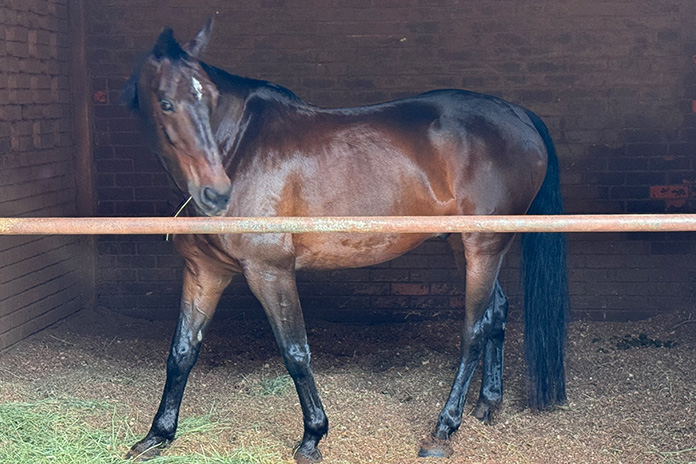
Land constraints have been a recurring theme in the Singapore Polo Club’s history. Founded in 1886 by officer’s of the King’s Own Regiment, 1st Battalion, the ‘Game of Kings’ was originally played in the centre of the old Singapore Race Course at Farrer Park. However, conflicts arose with golfers, who also shared the grounds, and the polo club relocated to Balestier Road in 1914, but there, too, the grounds would prove insufficient to house the necessary facilities.
The club was eventually allotted 1.2 hectares of land in its current location at Mount Pleasant Road, in 1941. During the Japanese occupation of WW2, the grounds were converted into a gun emplacement area and eventually a squatters’ camp. Post war, the club was re-established with effort from Lord Mountbatten and several royal dignitaries, receiving a 99-year lease, which is due to expire in 2038. This period of peace has given the club ample time to grow and flourish into a haven for polo enthusiasts and the social elite.
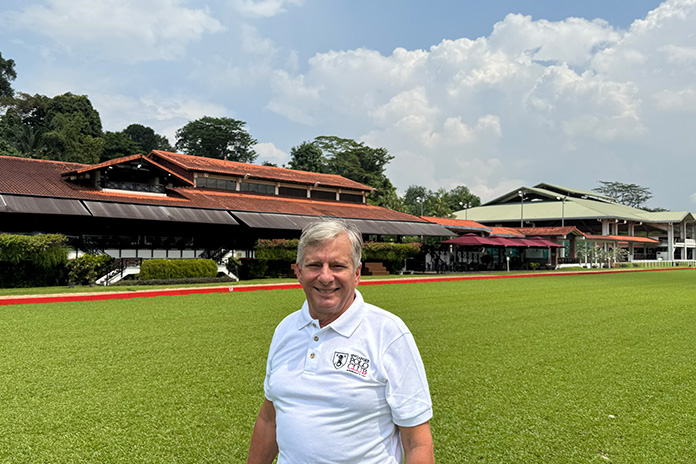
Club History
“It served an important role in the British army to be able to get their best officers to Singapore,” explains Club Vice President Rickard Hogberg, who has been a member for 39 years. “After the war, these officers helped build Singapore’s industry to some extent — Sembawang and Keppel shipyards, and a lot of the defence infrastructure. So, in some ways, we’re part of history, and now it’s more of a matter of, are we relevant for the future.”
While polo is popular in Argentina, Australia, New Zealand and several European nations, the Singapore Polo Club offers a unique experience, both in terms of its grounds and amenities. Coated with cow grass, maintaining the sand-based polo field requires periodic watering, fertilisation, and spiking, costing millions annually.
The club’s field can host around 100 polo players simultaneously, and has a sand track around its circumference for riding. Other riding facilities include a large indoor arena and a jungle trail. The club has facilities to stable 300 horses.
Beyond equestrian activities, the club features a gym, 15 club rooms, hotel rooms for members and their guests, a swimming pool, and a tennis court. Their restaurant and coffee shop are leased out to contemporary Pan-Asian restaurant operator Coriander Leaf.
As Rickard explains, the club stays focused. “We are not experts in catering. We focus on groundskeeping, stable and horse management. Those are our specialties, we don’t try to do everything.”
While expanding the utility of their membership, Rickard reasons that this uniquely broad range of facilities makes it difficult to offer reciprocal memberships. “There are very few other polo clubs in the world with our facilities. This means it’s difficult to support other clubs with our membership.”
Managed by a committee, the club’s management structure is also unique, as the majority of the world’s polo clubs are owned and managed by either individuals or families, such as those in India and China. Rickard elaborates on the benefits enabled by the club’s management model, “Most don’t have general membership facilities, or enable you to play polo on a field that was just cut up in the morning.”
Staying Relevant
The committee has made strides to broaden the experience on offer to expand the club’s relevance. As Rickard contextualises, only around half of the club members play polo.
“You don’t need to ride to be a member. Half of the members just come for the ambience, or to play tennis, or swim or have birthday parties, or they just like to see the horses.”
In other attempts to expand the utility and visibility of their facilities, the management is considering using the lawn for a pop concert, however such events could cause extensive damage to the polo field.
Singapore attracts global talent, including the social elite, some of whom, Rickard has observed, relocate to Singapore specifically to access the club’s world-class facilities.
“The King of games is the game of Kings. But today the kings are no longer kings of countries, they are often entrepreneurs of various industries. Some of them have gravitated to polo or equestrian sports because it takes a lot of skill to play, and it keeps you grounded. We have quite a few billionaires here. If Singapore didn’t cater for some riding, some golf, some polo, why would they stay here?”
Rickard admits that the sport itself is still largely restricted to the social elite due to the high cost of participation. “Even until today the game is quite expensive. It’s an exclusive sport for the elite, with around 100,000 players globally. So, we have to be more than just a polo club. The committee is now working on the relevance of this club, because we were quite fortunate that Lord Mountbatten and the British at the time gave the club a 99-year lease, which many other clubs are a bit jealous about.”
Memberships and Demographics
The club currently supports just under 1,500 ordinary members, and together with family members, totals around 6,000 members. The club offers two types of membership, standard and charter, with the latter category for those playing polo.
Regular memberships cost S$9,000 while charter memberships cost a similar amount, having come down in price from around $25,000 in recent years. Monthly subscription costs for family membership have risen to $144 for regular members and $244 for charter members. The club runs an annual net surplus from its facilities and amenities and rarely has to ask members for additional funding.
While many clubs allow the trading of memberships via private brokers, the Polo Club controls it in house.
The club’s expat to local ratio is currently around 60:40, but is steadily approaching 50:50. The club aims for majority local membership in the coming years and anticipates this happening long before the 2038 lease renewal.
Lease Renewal and Costs
From the Club’s veranda overlooking the grounds, it’s hard to miss the urban sprawl encroaching on the property.
“Every day I look out and there’s a new horizon. They will reclaim the land from the stables at the end of the property, because they need access to the new HDB estate. We have to be relevant to the needs of Singaporeans, and to expats who want to come and live here. We also have to be realistic; the club cannot only be for 100 polo players, it has to be for thousands, otherwise the dollar cost per square foot would be too great.”
The club also supports the local community. With the opening of neighbouring facilities, Riding for the Disabled (RDA) and the Equestrian Federation of Singapore (EFS), whose leases expire in 3 and 10 years, respectively, the surrounding 25 hectares have become an equestrian hotspot. The Singapore Polo Club will support both clubs with their lease renewal efforts, Rickard adds.
The committee has made moves to shore up supporting funds well in advance of the lease renewal, collecting an additional $300 per month from charter members.
Rickard is realistic about what to expect when the lease comes up for renewal. While there isn’t a duration in mind, he is not optimistic that the club will get another 99-year lease. He is hopeful that the merits of the club’s purpose in society, its inclusiveness and unique global position will be value-added elements that will also benefit Singapore’s standing.
“We are not looking for reciprocity, but for tourism value, so that more affluent tourists can fly in, play a game of polo, look at Singapore, and be impressed by Singapore.”
SINGAPORE CRICKET CLUB
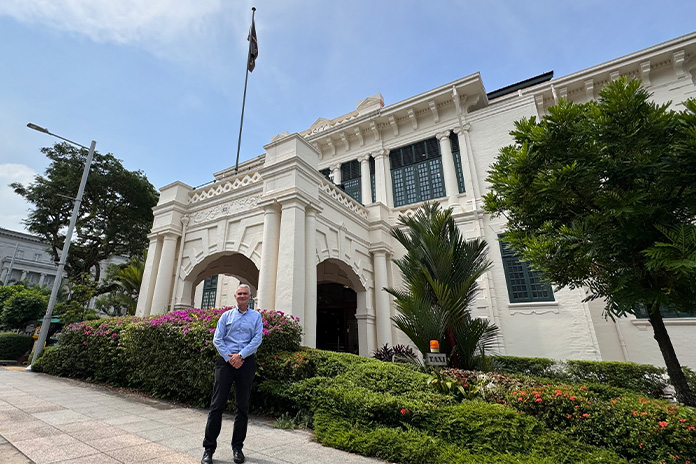
Club History
Sitting on the Padang in view of the central business district, the Singapore Cricket Club (SCC) cuts an iconic figure for its old-world charm against a backdrop of towering, gleaming skyscrapers.
As a heritage building on a recently gazetted national monument (the Padang), SCC serves as a custodian of the field it shares with the Singapore Recreation Club (SRC) at the opposite end.
The club was founded in 1853, with its first 28 members being clerks or junior assistants working in the British business and mercantile communities. By the 1880s the number of members had grown to over 400, with membership having become more prestigious.
Over the years, the membership has become more inclusive and currently stands at 6,500.
SCC’s General Manager, David Jones, notes the significance of the club’s location in its ongoing success. “Sports has always been at the core and is really part of our DNA, and I think that the Padang, as such an iconic location, and the heritage building, make it special. The club is also home to the second-oldest rugby 7s tournament in the world, the SCC International Rugby 7s (or SCC 7s), now nearing its 75th anniversary.
“While we refer to ourselves as a sports and social club, we have people who are a little more business focused, who use the club as a business networking environment, but in a more casual, friendly setting.”
Staying Relevant
David highlights the importance of an influx of youth members to ensure the club’s longevity, as well as increasing the proportion of local members. “The mix of young kids is both expat and local, but the ones who will continue on here will be the Singaporeans and they are the real future of the club.
“With sports like hockey, netball, tennis and squash, we have a lot of young girls joining the club, as well as older sportswomen. We also have women’s cricket and football teams that are doing well. We are always looking to balance male and female members.”
Currently, more than 30% of the members are female.
Jones believes the nurturing of young athletes through SCC’s academies is their best bet for sustaining youth membership. “You get high-quality coaching, mentorship, connection with people with similar interests.
“When youngsters get to the stage when they need to start thinking of careers, in many cases senior members have helped introduce them to people and point them in the right direction. So that’s part of our heritage and culture.”
The club has seen an influx of members post pandemic, and its good reputation abroad draws new members from the regular influx of foreign talent arriving in Singapore.
“A couple of years ago there was an outflow from Hong Kong and a number of people came to Singapore and joined SCC. Providing an environment for professionals to come here and enable them to conduct business in a more relaxed setting, plus the social and F&B part of it will always be important ingredients.”
Memberships, Demographics and Costs
The club’s main offerings are their sports sections, F&B, socials and tournaments. The club caters to 8 sports at a competitive level — cricket, rugby, football, hockey, squash, tennis, bowls and snooker — while also offering recreational darts, bridge and golf. Members are also privy to Formula 1 tickets, which David explains are to compensate for disruption of club activities caused by the event. “F1 is a big event for us, and has been since 2008. The club is closed off during that period. We purchase tickets from Singapore Grand Prix and we set the rates.”
Club members also get access to reciprocal clubs, of which there are over 100 globally.
The club sees an influx of 20 to 25 new members per month, as a combination of old members transferring membership to new members, and term members subscribing on an annual basis, for which there is no limit, to service expat demand.
David admits that private brokers facilitate membership transfers, with transfer fees of $10,000, but that the club does not monitor any of these transfers. The club does, however, control the membership waiting list, which can be up to 2 – 3 months.
The club currently has 4,200 members, and 6,500 family members. Membership subscription fees now sit at $130. David acknowledges that members voted for the increase of the subscription from $103.
Finally, David details the stance of the club in an inflationary environment. “I don’t think any club manager would argue at all about rising costs not being a major factor today. With monthly subs, we need to strike the right balance between increasing where necessary and making sure the club is being managed efficiently and members are still getting value for money. Over the last few years, our model has been tested, but, so far we’ve gotten through it reasonably well.”
The majority of the club’s income comes from subscriptions and F&B, which has been increasing since the pandemic.
Lease Renewal
In 2023 the club renewed its land lease for another 30 years, matching their previous 30-year lease. The lease renewal amounted to $11.434 million.
Jones credits the prudence of his predecessors in anticipation of the lease renewal. “Our war chest was built up over time. To be fair to previous general committees and management, this is something they thought about some time ago.
“The club has managed its funds well and we did not have to go to members to ask for money.”
SCC’s balance sheet is managed by experienced members who are part of the subcommittee that manages its funds. In terms of expectations for lease renewal, the club understands it must maintain its heritage, the Padang and the clubhouse.
SINGAPORE RECREATION CLUB
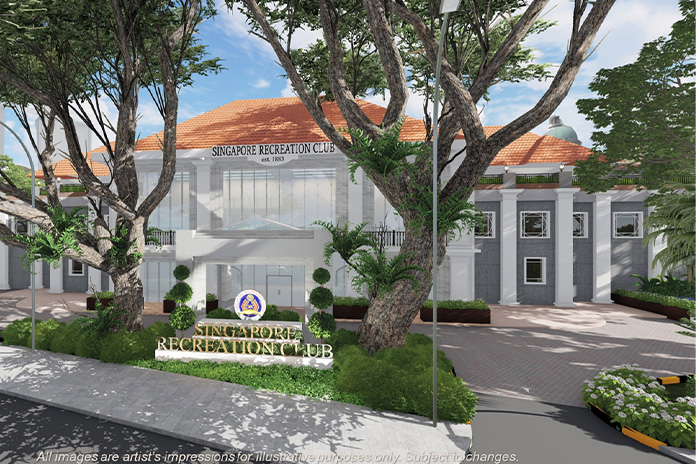
Club History
The Singapore Recreation Club (SRC) was founded in 1883, and has played a pivotal historical role in unifying the community as the third oldest club in Singapore. The club was established by Eurasian community members as the Straits Cricket Club in 1880.
Initially meeting at Waterloo Street, it played its first cricket match against the Royal Artillery in 1883 and later erected its first pavilion near St Andrew’s Road. By 1905, a second pavilion was built to accommodate growing attendance, featuring amenities like a large hall and committee meeting rooms. During World War II, the club was requisitioned by British authorities, and served various purposes under Japanese occupation before its rebirth in 1946.
In 1955, the club opened its membership to non-Eurasians, after newly elected Chief Minister David Marshall and two other non-Eurasians were given honorary memberships. The following year, subscription memberships were opened to non-Eurasians and women.
The club transitioned to a social club with transferable memberships in 1994, facilitating financial renewal and the construction of a new clubhouse in 1997, and offering modern facilities like a heated swimming pool and a bowling alley.
Celebrating its 141st anniversary in June 2024, SRC focuses on expanding its leisure offerings and creating a venue for social experiences, enabling members to foster deep connections between each other and with the venue.
Staying Relevant
SRC continues to expand its offerings with an array of sports, leisure activities and social events, as well making several updates to the interior facilities, while maintaining its external facade.
The club acknowledges the need to draw in new members, and is banking on a $16.6 million transformation plan to draw in a new cohort of members as its demographics continue to skew towards senior members.
SRC General Manager Desmond Tay recognises the club will face competition in this regard and notes that, “One of the primary challenges is the ageing demographic of our membership base, necessitating a continuous effort to attract younger members. Additionally, maintaining high demand for club membership remains crucial in today’s competitive landscape.”
Membership, Demographics & Costs
SRC’s 2023 annual report showed that there were 6,648 members — 4,129 Ordinary, transferable members, 1,630 family members and only 9 Term members. The club’s demographics span from 21 to 100 years of age, but over 63% are between 41 and 80 years old, with those aged between 60 and 70 being the largest cohort (24%). Just under 9% of the membership are lady members.
2023 saw 281 new members joining via membership transfer. The club recorded a 0.4% attrition rate in its annual report.
Ordinary members pay monthly subscription fees of $85, with an additional $40 for family members, and $20 for juniors. Term members pay $3,000 per year, and all members pay a one-time admin fee of an additional $252.
Regarding memberships, Desmond acknowledges that, “This figure may vary as our transformation progresses, reflecting our commitment to enhancing facilities and services. SRC’s strategic location and ongoing enhancements position it as a stable and prestigious recreational destination, offering unparalleled value to prospective members.”
The transformations mentioned by Desmond refer to the $16.6 million in upgrades that were voted on over 3 days in March, which committed those with transferable memberships to paying a one-time $3,000 contribution.
The planned upgrades will include additional indoor gaming facilities in level B2 for billiards, table tennis, mahjong and cards, upgrades to bars, function rooms and restaurants and the addition of amenities such as a cigar lounge and children’s play area. These will be in addtion to outdoor facilities for tennis, basketball and other sports.
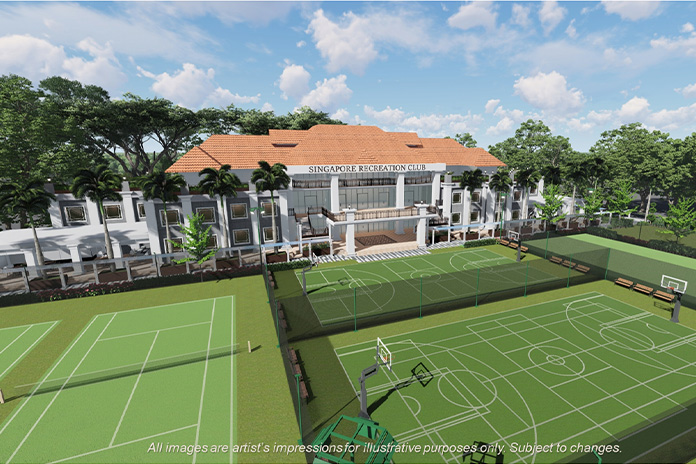
The 2023 annual report details the club’s funds of over S$20 million, dedicated to sports and maintenance, including a ‘Fixed Capital Fund’ of over $5.5 million, which is ‘the amount transferable out of the Development Fund for the development of the clubhouse’.
On the topic of increasing membership valuations over time and the prospect of members viewing memberships as an investment, Tay notes that, “Any potential increase in membership value in the open market is a natural by-product of our commitment to excellence.
“Furthermore, with the recent passage of the transformation resolution during the EOGM, we are poised to enhance our facilities and elevate the quality of the club, which may further contribute to the value of memberships.”
Members gain access to the club’s array of dining venues, including the Poolside Cafe, Cantonese restaurant Le Mansion, Oasis at the Padang Sport Bar, Barkers Lounge and Lounge 1883. Members can also engage in sporting activities at the Padang and Courtyard, utilise the underground pool, and the club gym.
Like other clubs, the majority of SRC’s revenue comes from subscriptions and F&B, accounting for over $13.5 million in 2023, up from over $12 million in 2022. Along with other clubs, the ageing jackpot room’s earning power has been smothered by regulation, decreasing from $273,000 in 2022 to $128,000 in 2023 and rapidly becoming insignificant.
Chairman of the Audit and Finance Committee Wee U-Jin has cited increasing operating expenditure of $2.8 million (21.2%) in 2023 due to higher labour cost, inflation of supply costs, contract services and the transition of Le Mansion.
Lease Renewal
In 2022, the club renewed its lease for an additional 30 years for a total of $17.7 million, which was funded by a combination of ordinary member contributions of $2,500 per member, and the remainder coming from the club’s reserves.
Desmond gives some context to the club’s funding history.
“This approach of members topping up, aligns with industry standards and echoes a longstanding tradition within SRC, dating back to the 1930s, when the club was rebuilt solely through member contributions.”
THE SINGAPORE ISLAND COUNTRY CLUB
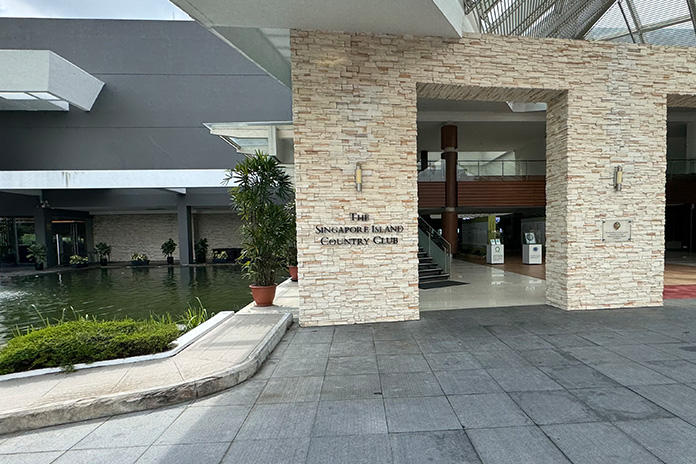
Club History
The Singapore Golf Club opened in 1891 at the old race course at Farrer Park. Accessible only to the British at that time, its popularity led to the construction of a $3,000 clubhouse in 1894. The club hosted the first Singapore Open Championship in 1905. Due to urban redevelopment of the surrounding area, the club moved to Bukit Timah, its 18-hole golf course opening in 1924.
In 1934, the Island Club, Singapore’s first multi-racial club was opened, a significant moment in the country’s history. The 1963 merger of the Royal Singapore Golf Club and the Island Club saw the formation of The Singapore Island Country Club (SICC).
The former Island Club building would be renovated and the $59 million Island Clubhouse reopened in 2011.
SICC celebrated its 60th anniversary in 2023, a year which also coincided with the official opening of the Bukit Clubhouse, a $66 million urban development with additional dining and wellness facilities. The club features a total of three golf courses and 63 holes across its 2 sites.
Land scarcity is a cause for concern for many Singapore clubs. Golf clubs, with their large footprints, are particularly at risk of losing land. Local golf clubs in particular are facing this existential crisis.
Leases for Keppel Club and Marina Bay Golf Course were not renewed, while three other clubs, including SICC, had to give up land but had their leases extended. Orchid Country Club’s lease will not be renewed after 2030.
Having been with the club since 2015, General Manager Ian Roberts, who oversees SICC’s net 250-hectare property, has been witness to the recent land reclamation of their Tanah Merah site, which lost 20 hectares, and their Bukit course which lost 7 hectares.
Roberts admits that barring some surprises, these closures are mostly unremarkable. “While all of Singapore’s golf clubs are financially feasible, they take up vast amounts of land and the government needs some of it for redevelopment.”
Staying Relevant
Hong Kong, which is roughly 1.5 times bigger than Singapore, has 5 golf courses, whereas Singapore has 17. Closures will reduce this to 13 by the end of the year. The Singapore Golf Association’s (SGA) 2018 Singapore Golf Industry Report emphasised the importance of junior programmes to ensure golf’s continued existence and growth in Singapore.
“Future participation numbers would likely heavily suffer were the level of junior programmes or junior access to golf facilities to fall.” The report stated that junior golfers account for 5% of total active golfers, with nine out of 10 golfers picking up the sport before they turn 35.
The same report found that 55% of Singapore’s golfers were over the age of 55, with only 7% of golf club members being below 35. The sport is also dominated by males — 83% — which poses an issue of imbalance.
Ian is optimistic that golf will continue to be popular, in keeping with global trends.
“I think golf is a very popular game across the world. I don’t see a problem in keeping the club running.”
As a sustainability expert, Ian has overseen the upgrading of the club’s facilities and equipment to optimise its energy usage.
“Solar panels have been deployed to help the club achieve its carbon neutral ambitions, and the new materials on the clubhouse comply with modern sustainable building standards. We also consider that there is a reservoir nearby and we are mindful of this when it comes to maintenance of the facilities.”
Membership, Demographics & Costs
SICC has a prestigious cohort including professionals and senior members of society. Networking is a key aspect of club membership. The most recent members survey revealed that 91% of SICC’s members are over 40. The 2018 SGA report found that 65% of Singapore’s golf club members were over 45 as of 2018.
The SGA report found that Singapore’s 12 private golf clubs have around 46,000 members in total, with an average of 3,800 per facility, and clubs reporting near 100% capacity. SICC hosts 17,200 members as of 2023 across its 2 venues, with 7,800 of these being principal members and the remainder being family members. Ian has observed that it is not uncommon for members to have membership at all four of Singapore’s major golf clubs.
The recent Covid pandemic and enforced lockdowns boosted the membership’s support on the course.
“It affected golf positively because everyone was stuck in their own country, and golf just exploded. Normally, up to 30% of members could be travelling at any one time, but the pandemic forced them all back.”
While average golf club membership pricing is currently around $86,000, since 1990 the average price has fluctuated between $124,000 (1992) and $54,000 (2005).
Current SICC local memberships are transferred at around $400,000 and foreign memberships are $900,000 (excluding transfer fees of $50,000 and $80,000, respectively). The limited number of term memberships, for expatriates and transient residents, cost $36,000 annually. SICC’s family subscription fee, recently having undergone a small increase, is around $300 per month.
The club recently introduced a playing fee, $5 for 9 holes, $10 for 18. According to the SGA survey, 24% of Singapore’s golf club members play weekly. Roberts notes that many members travel frequently, but more active SICC members play 3 to 4 times per week.
Jackpot rooms, once revenue generators for social clubs, are now run as more of a service at SICC. “We still have a jackpot room here but with government policies, they make it more and more difficult to run at a profit. We try not to encourage members to gamble.”
Ian does not anticipate an increase in memberships in the near future. “The club is already well utilised.”
Full members gain access to the club’s sports and dining facilities.
Roberts notes that F&B adds positively to the club’s bottomline. “In most clubs F&B loses money, and subscriptions help to counter the loss. For a 5-star facility in the middle of the forest with staffing and air-conditioning, the prices are very reasonable. The ingredients we use are of the highest quality.”
Lease Renewal
The Island Clubhouse’s lease will see it through to 2040, whereas the Bukit site will be due for renewal in 2030. Ian notes that the length of these leases are quite short for a large club. For example, the clubs on the Padang — Singapore Recreation Club (SRC) and Singapore Cricket Club (SCC) have 30-year leases. Like SRC and SCC, SICC is custodian to national heritage features such as a WW2 graveyard and protected trees on both its locations that cannot be touched.
The club’s 2023 annual report reveals a substantial amount of funds kept aside specifically for lease renewal, over $215 million. This has helped to cover the costs of the recent clubhouse renovations, as well as the frequent maintenance requirements of the clubhouses.
Ian explains the need for a substantial cash moat. “It’s always easy to spend money around here because of the size of the club. The building is about 12 years old and does require regular maintenance. This was a $100 million clubhouse when it was built. The cost to replace it would be off the charts.”
The club is embarking on its $24 – $38 million Island golf course redevelopment project, which is expected to be completed within 18 months.
While once viewed as investment opportunities, social clubs today may offer a more utilitarian value proposition. Changes in economic situations and government regulations may affect the value and demand for a club’s membership. So, anyone considering taking up a club membership should think about how it will influence your lifestyle and whether it’s ultimately going to be money well spent.
NOTE: All prices indicated are based on prices listed at time of publishing.





